 Commonly known as Brusco or Rusco in Spanish and Butcher’s broom in Englsih among other names. It is a perennial shrub of the Liliceae family about 25-100cm tall. The butcher’s broom has separate male nd female plants. Both have smooth, round, dark-green stems. Leaves are almost invisible, and what eems leaves are in reality cladodes, stem extensions in the shape of ovate-lanceolate leaves finishing in small spine. The flowers are greenish and very little showy. Female flowers are deeply six-cleft and the male flowers have welded stamens. The fruit is a red globose berry containing only one or two seeds; when ripe the fruit looks similar to a small cherry. Butcher’s broom is native to the Azores Islands, the Mediterranean area and the Northwestern regions of Europe up to Iran, being introduced later to other continents. It grows in areas that are 600-1000m. above sea level, on rough lands, forests, scrubs, ountainous areas and very often it does next to holm and cork oaks. Of its chemical composition steroid saponins stand out. The utcher’s broom actions are mainly due to its content of hexacyclic compounds derived from spirostane. The aglycones ruscogenin
Commonly known as Brusco or Rusco in Spanish and Butcher’s broom in Englsih among other names. It is a perennial shrub of the Liliceae family about 25-100cm tall. The butcher’s broom has separate male nd female plants. Both have smooth, round, dark-green stems. Leaves are almost invisible, and what eems leaves are in reality cladodes, stem extensions in the shape of ovate-lanceolate leaves finishing in small spine. The flowers are greenish and very little showy. Female flowers are deeply six-cleft and the male flowers have welded stamens. The fruit is a red globose berry containing only one or two seeds; when ripe the fruit looks similar to a small cherry. Butcher’s broom is native to the Azores Islands, the Mediterranean area and the Northwestern regions of Europe up to Iran, being introduced later to other continents. It grows in areas that are 600-1000m. above sea level, on rough lands, forests, scrubs, ountainous areas and very often it does next to holm and cork oaks. Of its chemical composition steroid saponins stand out. The utcher’s broom actions are mainly due to its content of hexacyclic compounds derived from spirostane. The aglycones ruscogenin
(19-hydroxydiosgenin) and neoruscogenin are released by hydrolysis. It contains rutin and hesperidin methyl-chalcone flavonoids. Lato Sensu flavonoids are pigments almost universally present in plants. Almost always water-soluble they are responsible for the colouring of flowers, fruits and sometimes leaves. Due to its content of saponins and therefore its phlebonotic properties, Butcher’s broom is used to improve and reactivate blood circulation in tired legs and in anti cellulite complexes.
